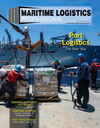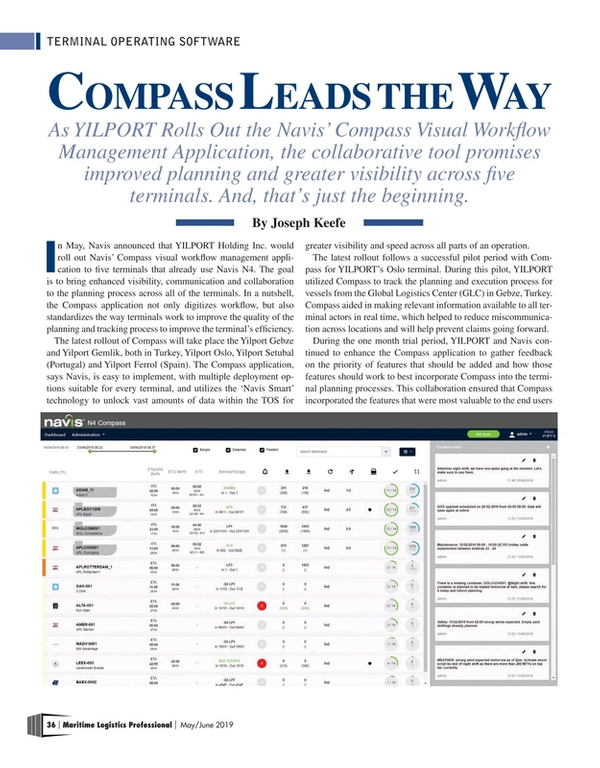
TERMINAL OPERATING SOFTWARE: Compass Leads the Way
As YILPORT Rolls Out the Navis’ Compass Visual Workflow Management Application, the collaborative tool promises improved planning and greater visibility across five terminals. And, that’s just the beginning.
In May, Navis announced that YILPORT Holding Inc. would roll out Navis’ Compass visual workflow management application to five terminals that already use Navis N4. The goal is to bring enhanced visibility, communication and collaboration to the planning process across all of the terminals. In a nutshell, the Compass application not only digitizes workflow, but also standardizes the way terminals work to improve the quality of the planning and tracking process to improve the terminal’s efficiency.
The latest rollout of Compass will take place the Yilport Gebze and Yilport Gemlik, both in Turkey, Yilport Oslo, Yilport Setubal (Portugal) and Yilport Ferrol (Spain). The Compass application, says Navis, is easy to implement, with multiple deployment options suitable for every terminal, and utilizes the ‘Navis Smart’ technology to unlock vast amounts of data within the TOS for greater visibility and speed across all parts of an operation.
The latest rollout follows a successful pilot period with Compass for YILPORT’s Oslo terminal. During this pilot, YILPORT utilized Compass to track the planning and execution process for vessels from the Global Logistics Center (GLC) in Gebze, Turkey. Compass aided in making relevant information available to all terminal actors in real time, which helped to reduce miscommunication across locations and will help prevent claims going forward.
During the one month trial period, YILPORT and Navis continued to enhance the Compass application to gather feedback on the priority of features that should be added and how those features should work to best incorporate Compass into the terminal planning processes. This collaboration ensured that Compass incorporated the features that were most valuable to the end users and help YILPORT to reach their strategic targets.
The End of Siloed Data Streams
Navis Chief Strategy Officer Andy Barrons describes the compass application as one which seamlessly consolidates multiple data sets into a single view. “Imagine you’re running a very busy terminal, you’ve got multiple vessel arrivals, you’ve got multiple berths – how do you manage optimize the planning of all those vessel visits? Compass provides an overview that can be shared amongst multiple end users within the terminal. It’s a change in the planning paradigm, to some extent, because you’ve got a team view.”
According to Barrons, the next level of Compass comes when the software starts to learn, recognizing the process and can start to be proactive in making a recommendation if there’s an exception in a particular work flow. “Ultimately, that’s where Compass will develop. The software is looking at all the data and then making decisions of what’s the next best move in the terminal.”
The initial release of Compass is for terminal planners only. It facilitates end-to-end planning for vessel visits, by the team in the terminal. Over time, the Navis vision is to connect other planning operations within the terminal – barge planning, truck planning, etc. Barrons explains further, “What’s exciting about Compass is that it is the start of a new kind of planning paradigm. Compass takes advantage of new technology we’re employing called ‘Navis Smart.’ And, why that’s exciting for customers, is that you can build applications on top of the core TOS without having to upgrade the system. A core operating system, you have to upgrade from time to time, to get the new functionality to your team in the terminal.”
Through Navis Smart, functionality is delivered much faster to a terminal than it was ever to be done in the past. As a starting point, says Barrons, one of the strengths of Navis is that it is highly configurable. “We’re in about 350 terminals around the world. And so when you’re building software for a global market, you have to make the software highly configurable in order to meet the different workflow processes or different ways they want to use the functionality. For example, we’re working on what’s called BI Portal Analytics and Ops Monitoring dashboards. The user can see what happened when they worked that last vessel and how that can be improved in the future.
At Navis, the current view is that data is the biggest untapped asset in terminals. Capturing, combining and analyzing that stovepiped data will eventually drive innovation, says Barrons. Previous improvements involve terminal design, automation, and increased productivity. Looking ahead, Compass is an example of how data that is sitting in multiple different places within a core system can be brought together so that the planning process is easier – and faster.
Compass Points the Way
As terminals evolve, the terminal operating systems that help them get the job done will also become more sophisticated. That sophistication, however, translates into easier metrics, a single source view of all data streams that, in turn, will produce greater efficiencies. Andy Barrons sums it up neatly by saying, “It is really about continuously improving operational performance within these critical nodes in the supply chain.”
For its part, YILPORT already uses the Navis N4 Terminal Operating System (TOS) at 9 terminals and they are working to standardize on N4 as their TOS for their strategic terminals. YILPORT’s long term vision is to become a top 10 global port operator by 2025. The numbers indicate that the company is well on its way to achieving this target. Recently, YILPORT Holding was ranked as the 12th biggest international terminal operator in the world (source: Drewry’s 2017 ranking). As they grow, it looks like Navis will be a big part of their ongoing success.
This article first appeared in the MAY/JUN 2019 edition of Maritime Logistics Professional magazine.
Read TERMINAL OPERATING SOFTWARE: Compass Leads the Way in Pdf, Flash or Html5 edition of May/Jun 2019 Maritime Logistics Professional
Other stories from May/Jun 2019 issue
Content
- INSIGHTS: John F. Reinhart, CEO, Virginia Port Authority (VPA) page: 10
- SHORTSEA SHIPPING: All the Right Moves (Finally) page: 14
- Southern Ports are Getting with The Program… page: 18
- Ramping (Up) to Lift Port Production page: 18
- Delivering parts, fuel, mail over 52 million square miles page: 24
- Connecticut Port Authority: the future is now page: 32
- TERMINAL OPERATING SOFTWARE: Compass Leads the Way page: 36
- SATCOM SOLUTIONS: Cruising in the Cloud page: 42
- Shipping Losses Lowest This Century as New Dangers Emerge page: 45


